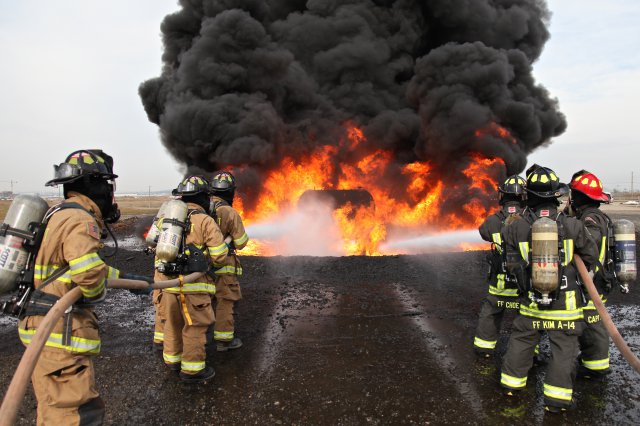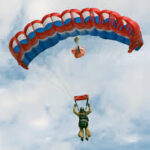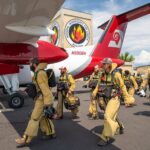
by Sarah Thompson
In the heart of wildfire season, when flames rage uncontrollably and smoke clouds the sky, a select group of courageous individuals known as smokejumpers answer the call of duty. These elite firefighters embark on daring missions, parachuting into the heart of infernos to confront the blaze head-on. In this blog article, we delve into the world of smokejumpers, exploring the adrenaline-fueled experiences and on-the-ground actions of these fearless men and women who risk their lives to protect communities and natural landscapes.
Smokejumpers are highly trained firefighters who specialize in parachuting into remote areas to combat wildfires. Unlike traditional firefighters who rely on ground transportation to reach fire sites, smokejumpers are deployed swiftly from aircraft, allowing them to access rugged terrain and inaccessible locations where wildfires often ignite. Equipped with specialized gear and extensive training, smokejumpers play a critical role in initial attack efforts, containing wildfires before they spiral out of control.

Becoming a smokejumper requires exceptional physical fitness, mental fortitude, and rigorous training. Prospective candidates undergo a demanding selection process, which includes rigorous physical tests, psychological evaluations, and wilderness survival assessments. Once selected, recruits undergo intensive training that encompasses parachute jumping, fire suppression techniques, emergency medical skills, and navigation in remote wilderness areas. This comprehensive training equips smokejumpers with the skills and confidence needed to confront the unpredictable challenges of wildfire suppression.
When a wildfire ignites in a remote or inaccessible area, smokejumpers are often the first responders on the scene. Upon receiving a call to action, smokejumpers swiftly board aircraft, laden with firefighting equipment and parachutes, ready to leap into action. As the aircraft approaches the drop zone, tension mounts among the smokejumpers as they prepare to jump into the unknown. With nerves of steel, they leap from the aircraft, hurtling towards the earth below, where flames lick at the landscape and smoke billows ominously.
Upon landing, smokejumpers waste no time in assessing the situation and formulating a plan of attack. They quickly gather their gear, including fire-resistant clothing, hand tools, chainsaws, and water pumps, and begin the arduous task of containing the blaze. Working tirelessly amidst the heat and smoke, smokejumpers employ a variety of tactics, including digging fire lines, setting backfires, and dousing hot spots with water or fire retardant. Their goal is to create a perimeter around the fire, preventing its spread and protecting nearby communities and natural resources.

The life of a smokejumper is fraught with danger, as they confront extreme weather conditions, rugged terrain, and unpredictable fire behavior. High winds, intense heat, and rapidly shifting fire patterns pose constant threats to their safety, requiring vigilance, adaptability, and quick thinking. Despite the inherent risks, smokejumpers remain undeterred, driven by a sense of duty and camaraderie, knowing that their efforts can make a difference in the fight against wildfires.
Success in wildfire suppression relies on effective teamwork and collaboration among smokejumpers and other firefighting personnel. Smokejumpers often work alongside hotshot crews, helitack teams, and aerial firefighting resources to coordinate efforts and maximize effectiveness. Communication is key, as smokejumpers relay vital information about fire behavior, weather conditions, and resource needs to incident command centers and other firefighting units. By working together seamlessly, smokejumpers and their colleagues form a formidable frontline defense against wildfires.
Beyond the physical challenges of smokejumping, there is also an emotional toll that weighs heavily on firefighters. Witnessing the destruction of homes, wildlife habitats, and cherished landscapes can take a psychological toll, leading to stress, anxiety, and trauma. Additionally, the inherent risks of the job can lead to feelings of fear, uncertainty, and vulnerability. To address these challenges, many firefighting agencies offer mental health support services and resources to help smokejumpers cope with the demands of their profession.
As wildfires continue to ravage landscapes and threaten communities around the world, the role of smokejumpers remains indispensable in the fight against these devastating infernos. Through their courage, skill, and unwavering dedication, smokejumpers exemplify the spirit of resilience and sacrifice, risking their lives to protect lives, property, and natural resources. As we salute their bravery and selflessness, let us also recognize the importance of supporting and honoring these unsung heroes who stand on the front lines of wildfire suppression.










